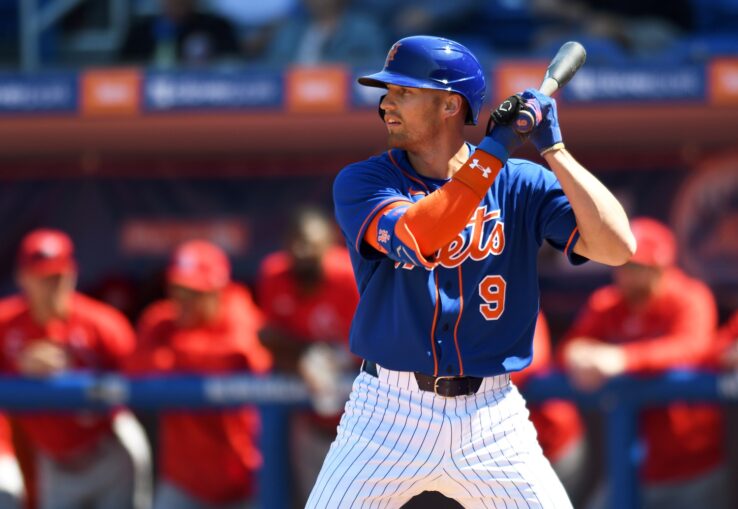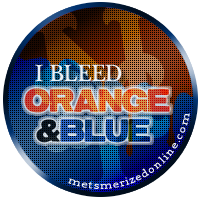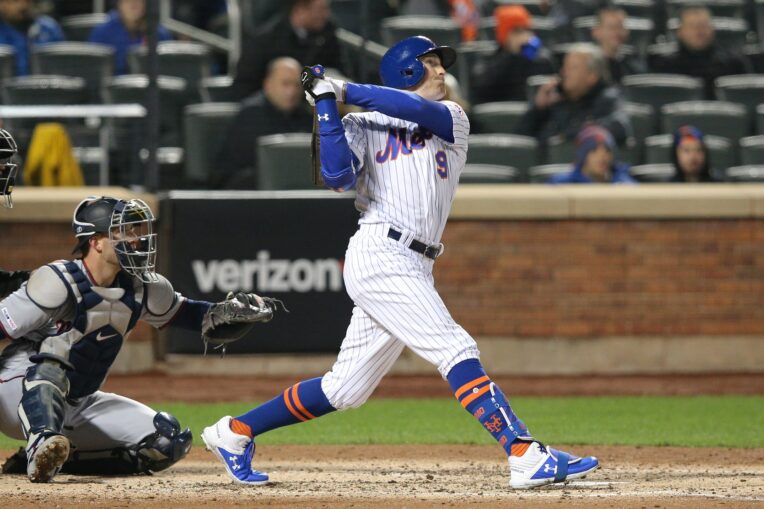
Now that he’s got all the heart tests behind him, it sure is nice to see Brandon Nimmo doing his thing on the baseball diamond again.
While we need to take Spring Training stats with a grain of salt, he’s looking like his usual self through 11 at-bats, evidenced by a .364/.500/.455 triple slash. After going 1-for-2 with a run scored in Friday’s win against the St. Louis Cardinals, he chatted with SNY’s Steve Gelbs about a few different things.
One of the topics they discussed was what exactly he was working on at the plate leading up to Opening Day. This is how he described the refinement of his approach (via Alex Smith of MetsBlog):
“I think it’s just that controlled aggression approach, and the more pitches that I see, the better I’m going to get at that, and I’m just going to keep working on trying to fire on those pitches in the zone.”
For someone who doesn’t have a problem with plate discipline and taking walks, this is the perfect kind of progression for an outfielder entering his age-27 campaign. He’s approaching that perfect part of his career where he’s going to be experiencing his physical peak and has accumulated enough big-league playing time to start putting everything together.
This “controlled aggression” stuff, though, isn’t exactly a new development for Nimmo. It’s something he’s been consistently improving upon since landing in New York. Below is a quick look at how his chase rate (O-Swing%) and swing rate on strikes (Z-Swing%) has changed from year-to-year since 2016:

When looking at his yearly walk rate since 2017, Nimmo has consistently produced one of the highest rates among players with at least 210 plate appearances. Despite this past season being a lost one because of a slow start and injury, Nimmo still put up an 18.1% walk rate — second only to some guy named Mike Trout (18.3%) — while posting single-season personal-best marks in swings both inside and outside the strike zone.
If we break down Nimmo’s 2019 season into pre- and post-IL stints, we can see that increased aggression in the right situation (i.e. when he sees strikes) was undoubtedly part of his strong September. The below table also displays the corresponding contact rates to show the impact of his increased aggression at the plate:

The slow progression he’s seen in these categories on a year-to-year basis should keep Nimmo encouraged to keep working on getting more aggressive in the appropriate situations. However, the comparison of these two periods of time (including the results, of course) could be drivers in continuing his journey to mature as a hitter.
Although it was way too short, there were other encouraging signs from Nimmo that stemmed from his continually improving plate approach, like his batted-ball profile.
If we compare the frequency of certain batted-ball events and the quality of contact from last year to his breakout 2018 campaign, we can see this approach paying dividends. His hard-hit rate dropped a couple percentage points, but it was still at a very respectable 35.6% while improving his soft-hit rate by four percentage points. This led to slightly more line drives, considerably fewer ground balls (45.0% to 38.8%) and more fly balls (33.3% to 38.0%). Almost just as important, too, was the change in his infield-fly rate, which went from 12.4% in ’18 to 4.1% last year.
It’s not totally fair to compare these two performances because the sample sizes are so uneven, but still, this is a good exercise to see how Nimmo’s controlled aggression has been a years-long process that he’s been continually refining and improving upon. Judging from the numbers he produced in September, we could be in for a big year from the big-hearted outfielder.
The Mets’ offense was an asset to the club in 2019 (at least, more than in recent years). A healthy Nimmo (and Cespedes, for that matter) gives the lineup much more depth and allows manager Luis Rojas with even more flexibility on a day-to-day basis. New York does have some options to choose from for a consistent leadoff hitter, but in my eyes, Nimmo should easily be the pick.
It’s hard to contain my excitement when thinking about him getting on base nearly 40% of the time in front of guys like Jeff McNeil, Pete Alonso, and Michael Conforto. Here’s to hoping Nimmo not only continues progressing in this respect of his game, but that he also pairs it with good health to build upon his 2018 performance.














